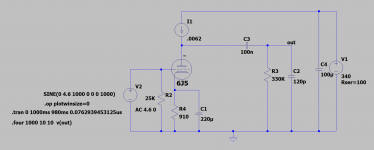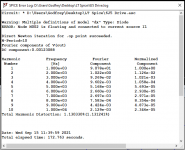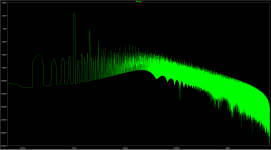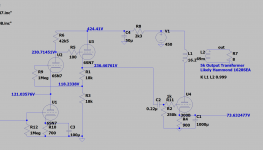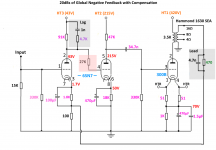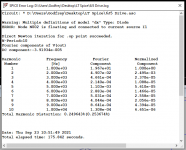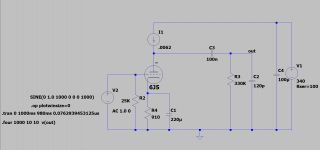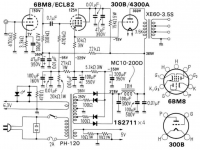Jack Elliano has a direct Coupled 300B thats been in my folder called "my first 300B" schematics for some time. Just throwing it out there because it is so simple and that multi tap resistor sure makes it easy to trim the operating point for a direct Coupled amp. Ultrapath cathode bypass. 700 V is high for a beginner like me, but I'm careful. 300B should love 700V. I have a One Electron OPT waiting to be used, but Id order the 60H chokes from Jack. Then later get some OPT's from Jack as well. I think DRD is Jacks abbreviation for "Direct Reactance Drive".
Electra-Print.com 300B DRD Audio Tube Amplifier
I build several amps inspired by Elliano's DRD amp using his AC8037 plate choke a decade or so ago using an assortment of driver tubes. I really liked the E180F (triode connected) as a driver using LED bias. The driver needs to have a cathode current of <15mA to use with the choke. I never made it with variable resistors, instead I used them to dial in the various voltages and replaced them with fixed resistors.
With the DRD amp, I have never used a power supply voltage over about 500Vrms because that's what my Electra-Print power supply transformer gives me with a capacitor input supply. I agree it is safer than 700V, but not by much. It also means that one can use 600V Wima MKP4 capacitors.
A 300B amp with the 500V plate supply will have a P-K voltage of about 300V with another 125V for the driver tube. I was not able to drive the 300B with my setup to more than 5W because of the low B+. This was the first of many direct coupled amplifier and it convinced me that direct coupling had some benefit to sound quality.
Is your heart set on a 300B?
My first SET was an 2A3 Free Lunch.
I wouldn't build that exact amp again, but I love the 417A driving the 2A3.
Regards,
Dan
My first SET was an 2A3 Free Lunch.
I wouldn't build that exact amp again, but I love the 417A driving the 2A3.
Regards,
Dan
Thanks for the replies everyone, I have some more experimenting to do!
I do like the idea of a 3 stage amp with a choke loaded driver that some have mentioned. This might be doable with the 6BM8. Failing that I will scrap the 6BM8 and do a cascode followed by source follower.
Thanks again for all the suggestions, I've enjoyed learning about the huge range of possibilities!
I do like the idea of a 3 stage amp with a choke loaded driver that some have mentioned. This might be doable with the 6BM8. Failing that I will scrap the 6BM8 and do a cascode followed by source follower.
Thanks again for all the suggestions, I've enjoyed learning about the huge range of possibilities!
Mentioning 6BM8 I remembered this one. I don't think a direct cathode Follower driver was posted yet.
View attachment MJ^9404_(03)three-300B-single-amps_ChoM.pdf
View attachment MJ^9404_(03)three-300B-single-amps_ChoM.pdf
Single Stage 6J5.
A single 6J5 with a CCS as a load gives exactly what is needed to drive a 300B - plenty of linear volts with very low distortion. 90 Volts for an input of 4.6 (LT Spice uses peak volts).
A good preamp is exactly what the first stage is in the circuit shown in post #1.
A single 6J5 with a CCS as a load gives exactly what is needed to drive a 300B - plenty of linear volts with very low distortion. 90 Volts for an input of 4.6 (LT Spice uses peak volts).
Attachments
Last edited:
Thanks for the responses everyone, I have considered all of them and decided to go for a no GFB design given that is what I have been enjoying with my little triode connected EL34 amp.
And yes my heart is set on a 300B or 6C33C.
Looks like I won't be able to get the 6BM8 circuit to work satisfactorily, so how about something like this? I realise it's not exactly a beginner circuit as it will need several elevated heater supplies, but it seems to offer the most promise. The only major shortfall I see is the low operating voltage of the input tube - way outside the linear region. I pushed it up about as high as I can. Wondering if maybe I should try a 6922 or 6DJ8 in this location perhaps...or any other readily available suggestions?
Look forward to your feedback.
Cheers,
Greg
And yes my heart is set on a 300B or 6C33C.
Looks like I won't be able to get the 6BM8 circuit to work satisfactorily, so how about something like this? I realise it's not exactly a beginner circuit as it will need several elevated heater supplies, but it seems to offer the most promise. The only major shortfall I see is the low operating voltage of the input tube - way outside the linear region. I pushed it up about as high as I can. Wondering if maybe I should try a 6922 or 6DJ8 in this location perhaps...or any other readily available suggestions?
Look forward to your feedback.
Cheers,
Greg
Attachments
Last edited:
Thanks for the responses everyone, I have considered all of them and decided to go for a no GFB design given that is what I have been enjoying with my little triode connected EL34 amp.
And yes my heart is set on a 300B or 6C33C.
Looks like I won't be able to get the 6BM8 circuit to work satisfactorily, so how about something like this? I realise it's not exactly a beginner circuit as it will need several elevated heater supplies, but it seems to offer the most promise. The only major shortfall I see is the low operating voltage of the input tube - way outside the linear region. I pushed it up about as high as I can. Wondering if maybe I should try a 6922 or 6DJ8 in this location perhaps...or any other readily available suggestions?
Look forward to your feedback.
Cheers,
Greg
Good
Last edited:
6922 / 6DJ8 / ECC88 was designed for use in a cascode, so I'd say that would be well worth investigating for your first stage.
I understand why a person might want to build their own SET and do so on a commonly highly regarded tube like the 300B, but for a first-time build I would recommend getting your feet wet on something much easier and simpler. The reason is if you have no experience in electronics the phase at where you build it and it doesn't work, the troubleshooting could be a bit over a newcomers head.
The last build I did, and I have built hundreds of amps, didn't work the first time I fired it up. Fortunately rarely with tubes is there smoke or ruined parts. Even a breadboard I made this week to test Gm in a specific tube type for matching didn't work the first time. We are human and make mistakes. With me it is because I am going from what is in my head where I should make out a schematic on paper first, but I am usually too much in a hurry. And I forget when I make one change in a circuit on the fly, that usually I need to make other changes.
That said my suggestion is to make a simple Spud amp, based on something like the 12HG7 tube, the entire parts list would probably cost you under $100 and it would give you the experience needed for a more complex project. I envy these guys and build one amp and that is it for the rest of their lives, I on the other hand am too attacked to vacuum tube build exploration. I have more ideas in my head than time in a day/week/year to do them all. But my best discoveries have actually started out as mistakes, so sometimes mistakes can be a good thing.
Terry
P.S. If you build something and it doesn't actually work and you can't get it to, I'll always be interested in buying it off you for the parts.
The last build I did, and I have built hundreds of amps, didn't work the first time I fired it up. Fortunately rarely with tubes is there smoke or ruined parts. Even a breadboard I made this week to test Gm in a specific tube type for matching didn't work the first time. We are human and make mistakes. With me it is because I am going from what is in my head where I should make out a schematic on paper first, but I am usually too much in a hurry. And I forget when I make one change in a circuit on the fly, that usually I need to make other changes.
That said my suggestion is to make a simple Spud amp, based on something like the 12HG7 tube, the entire parts list would probably cost you under $100 and it would give you the experience needed for a more complex project. I envy these guys and build one amp and that is it for the rest of their lives, I on the other hand am too attacked to vacuum tube build exploration. I have more ideas in my head than time in a day/week/year to do them all. But my best discoveries have actually started out as mistakes, so sometimes mistakes can be a good thing.
Terry
P.S. If you build something and it doesn't actually work and you can't get it to, I'll always be interested in buying it off you for the parts.
Last edited:
Hi Terry,
Those are fair comments; however, let me state my case.
Ok I'm no tube guru but I have designed and built literally hundreds of solid state amplifiers from utter scratch. I am well aware of the iterative construction and debugging process involved. I have also built numerous Tesla coils, one of which runs off a 25kW 22kV supply, all designed and figured out in the pre internet days before they became mainstream. I believe I can handle the basic design and construction myself and am aware that testing all key voltages should be done incrementally with a variac.
I live in Australia where parts (particularly transformers) are very expensive and this amp is going to cost well over $1k. It seems best just to chase what I want first time. I figure that while there might be some circuit finessing required, I should be able to get the basic parts (key tubes, chokes and transformers) about right first go (with assistance from this forum). This is why I am posting my ideas here and looking for feedback. Once I settle on a basic layout I will share my thoughts on a possible power supply and heater elevation system. Even if my circuit proves to be terrible I am happy to rework it all, but I would rather not be buying new output tubes or transformers.
Those are fair comments; however, let me state my case.
Ok I'm no tube guru but I have designed and built literally hundreds of solid state amplifiers from utter scratch. I am well aware of the iterative construction and debugging process involved. I have also built numerous Tesla coils, one of which runs off a 25kW 22kV supply, all designed and figured out in the pre internet days before they became mainstream. I believe I can handle the basic design and construction myself and am aware that testing all key voltages should be done incrementally with a variac.
I live in Australia where parts (particularly transformers) are very expensive and this amp is going to cost well over $1k. It seems best just to chase what I want first time. I figure that while there might be some circuit finessing required, I should be able to get the basic parts (key tubes, chokes and transformers) about right first go (with assistance from this forum). This is why I am posting my ideas here and looking for feedback. Once I settle on a basic layout I will share my thoughts on a possible power supply and heater elevation system. Even if my circuit proves to be terrible I am happy to rework it all, but I would rather not be buying new output tubes or transformers.
I understand why a person might want to build their own SET and do so on a commonly highly regarded tube like the 300B, but for a first-time build I would recommend getting your feet wet on something much easier and simpler. The reason is if you have no experience in electronics the phase at where you build it and it doesn't work, the troubleshooting could be a bit over a newcomers head.
.
Last edited:
Honestly, I would start with your speakers, what you expect from them and then work towards the source. If you have efficient speakers in a fairly small room, that's very different need than inefficient speakers in a large room. If you don't need the power a 300B can produce, there isn't a lot of reason to use them IMHO. An EL34 SE amp can sound fantastic.
Honestly, I would start with your speakers, what you expect from them and then work towards the source. If you have efficient speakers in a fairly small room, that's very different need than inefficient speakers in a large room. If you don't need the power a 300B can produce, there isn't a lot of reason to use them IMHO. An EL34 SE amp can sound fantastic.
Good advice about speakers. If you can manage something quite sensitive that opens doors for SET amps. I have several 300b amps and one amp with 6C4C which has 15W dissipation just like a 2a3. This is the amp I'm currently listening to and I really like it a lot. All my amps are 2 stage. I use an input valve with a mu of at least 30 in triode - a 6J5 though nice doesn't have enough gain for normal use without a preamp. I personally don't use a preamp - just 2 stages from my DAC input. And I want to use a DHT in the output, not an EL34 or anything like that. So I'd start with a 300b, 2a3 or 6C4C which is cheap from Russia.
For the input stage you can use a pentode in triode - plenty of discussion of those. Or a true triode like 6S4P, 6S3P or EC86. Or Stephe's cascode 6SN7 in her video series on the 300b. Loads of choices here. Resistor load, plate choke like even Hammond 157G or Gyrator from Bartola Valves website. Take your pick. Have a good look through the Bartola Valves website - there are loads and loads of circuits there with schematics and instructions. All very up to date and cutting edge with solid state devices like active loads, source followers etc to augment the 2 stage circuits.
Thanks everyone, all points taken and appreciated.
After trying to come up with lots of models I am getting more open to using a few solid state parts in there somewhere. Definitely seems like the best way to implement a CCS without the hassle of elevated heaters, etc. Will keep plugging away at ideas.
P.S. for those tying to sway me away from 300B's they happen to be the one part I already have so it's a done deal!
After trying to come up with lots of models I am getting more open to using a few solid state parts in there somewhere. Definitely seems like the best way to implement a CCS without the hassle of elevated heaters, etc. Will keep plugging away at ideas.
P.S. for those tying to sway me away from 300B's they happen to be the one part I already have so it's a done deal!
I went through a period of making lots of models of SE 300B amps and found that they all wound up with THD of about 0.5% at 1W rms output. That's predominantly second harmonic, true, but that's still considered to be an audible level of THD.
Is that par for the course for SE 300B amps that do not use global or local NFB? Or are there topologies that produce lower THD than that?
Is that par for the course for SE 300B amps that do not use global or local NFB? Or are there topologies that produce lower THD than that?
Do load-lines on the design and you will find it is totally unacceptable. Best redesigned as wither cascaded CC stages or a Cascode driver.
I went through a period of making lots of models of SE 300B amps and found that they all wound up with THD of about 0.5% at 1W rms output. That's predominantly second harmonic, true, but that's still considered to be an audible level of THD.
Is that par for the course for SE 300B amps that do not use global or local NFB? Or are there topologies that produce lower THD than that?
Of course, it's par for the course. Isn't that what we like about tubes - I prefer to call it colouration. Although I do believe in a fairly distortion (colouration) free driver section. It allows the 300B to shine through.
Do load-lines on the design and you will find it is totally unacceptable. Best redesigned as wither cascaded CC stages or a Cascode driver.
I use a CCS as a load in the driver stage for the 300B. The load-line is almost horizontal, when a large value of Rg is used for the 300B. Here, distortion is 0.25% with 1 Volt peak input at 1KHz.
Attachments
Do load-lines on the design and you will find it is totally unacceptable. Best redesigned as wither cascaded CC stages or a Cascode driver.
I use a CCS as a load in the driver stage for the 300B. The load-line is almost horizontal, when a large value of Rg is used for the 300B. Here, distortion is 0.25% with 1 Volt peak input at 1KHz.
I like this one!
Thanks for this Windcrest77! I like the 6BM8 cathode follower idea. For those who haven't read the link I attach the relevant schematic below.
I would like to build an amp similar to this one. The key difference would be that I would use a tube rectifier for the B+ supply and solid state rectifier for the negative supply to ensure the bias supply reaches full potential first. I may also contemplate a CCS load for the input tube.
Now a quick question... The cathode of the input triode is at approx zero volts (give or take). The cathode of the pentode is at approx -75V, and likely to go much lower than this to drive the 300B to full output. Given the two devices share
the same heater and max Vhk for the 6BM8 is 100V, what is the best strategy for the heater supply? Should it be elevated (de-elevated?) to minus 50V or something? Or best just to tie to ground as per the schematic?
Also, can someone explain the purpose of the diodes and 470R resistor in the 6.3V bias supply?
Many thanks,
Greg
Mentioning 6BM8 I remembered this one. I don't think a direct cathode Follower driver was posted yet.
Thanks for this Windcrest77! I like the 6BM8 cathode follower idea. For those who haven't read the link I attach the relevant schematic below.
I would like to build an amp similar to this one. The key difference would be that I would use a tube rectifier for the B+ supply and solid state rectifier for the negative supply to ensure the bias supply reaches full potential first. I may also contemplate a CCS load for the input tube.
Now a quick question... The cathode of the input triode is at approx zero volts (give or take). The cathode of the pentode is at approx -75V, and likely to go much lower than this to drive the 300B to full output. Given the two devices share
the same heater and max Vhk for the 6BM8 is 100V, what is the best strategy for the heater supply? Should it be elevated (de-elevated?) to minus 50V or something? Or best just to tie to ground as per the schematic?
Also, can someone explain the purpose of the diodes and 470R resistor in the 6.3V bias supply?
Many thanks,
Greg
Attachments
- Home
- Amplifiers
- Tubes / Valves
- Advice for first SET amp build
